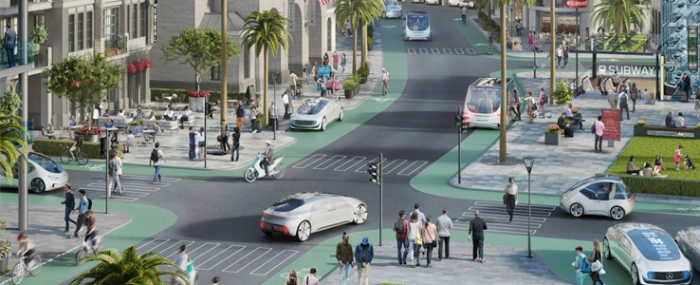
© Bosch
Electronics Production |
Metropolis in California to become a pilot city for automated driving
Bosch and Daimler are speeding up the development of fully-automated and driverless driving (SAE Level 4/5) in the city and are decisively setting the course.
The partners have chosen California as the pilot location for the first test fleet. In the second half of 2019, Bosch and Daimler will offer customers a shuttle service with automated vehicles on selected routes in a Californian metropolis. Daimler Mobility Services is envisaged as the operator of this test fleet and the app-based mobility service.
The pilot project aims to demonstrate how mobility services such as car sharing (car2go), ride-hailing (mytaxi) and multi-modal platforms (moovel) can be intelligently connected to shape the future of mobility. In addition, the partners have decided on the US technology company Nvidia as the supplier of the artificial intelligence platform as part of their control unit network.
For the joint development of a driving system for fully-automated and driverless vehicles, Bosch and Daimler rely on their automotive expertise accumulated over many decades to bring mature and safe innovations to market. “The decisive factor is to introduce a safe, dependable and mature system,” says Dr. Michael Hafner, Head of Automated Driving at Daimler AG. “Safety has the highest priority, and is the constant theme of all aspects and development stages on our way to the start of series production. If in doubt, thoroughness comes before speed.”
“Developing automated driving to a level ready for series production is like a decathlon”, according to Dr. Stephan Hönle, Senior Vice President Business Unit Automated Driving at Robert Bosch GmbH. “It’s not enough to be good in one or two areas. Like us, you have to master all disciplines. Only then will we succeed in bringing automated driving to the roads and the city safely.”
Evaluation of sensor data within milliseconds
A decisive factor for fully-automated and driverless driving in an urban environment is the reliable recognition of the vehicle’s surroundings with the aid of various sensors. Analyzing and interpreting the variety of incoming data and translating them into driving commands within a very short time requires enormous computing power – the fully-automated, driverless vehicle will be a mobile super-computer. At the same time, fully-automated, driverless driving in the city requires a versatile, redundant systems architecture and the highest level of functional safety. To achieve this level of safety, the necessary computing operations are performed in parallel in different circuits. This means that the system has instant recourse to these parallel computing results when necessary.
For their driving system, Bosch and Daimler thus rely on a control unit network made up of several individual control units. The US technology company Nvidia supplies the platform required for this, which can run the Artificial Intelligence (AI) algorithms generated by Bosch and Daimler for the vehicle’s movement. The network of control units collates the data from all sensors with radar, video, lidar and ultrasound technology (sensor data fusion), evaluates them within milliseconds and plans the movements of the vehicle. All in all, the control unit network has a computing capacity of hundreds of trillion operations per second. That’s as much as several S-Class vehicles together could reach just a few years ago.
The control unit network will also be used in the fleet vehicles which Daimler and Bosch will put on the roads of California in the second half of 2019. The test operation will provide information about how fully-automated and driverless vehicles can be integrated into a multi-modal transport network.
